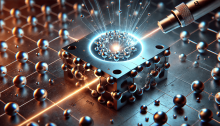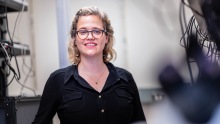An international team led by Canadian physicists from the UBC, SFU and TRIUMF have used microwaves to manipulate anti-hydrogen atoms. The findings, to be published Wednesday in the journal Nature, provide the world with its first glimpse of an "anti-atomic fingerprint." "For decades, scientists have wanted to study the intrinsic properties of antimatter atoms in the hope of finding clues that might help answer fundamental questions about our universe," says lead author Mike Hayden, a physicist with Simon Fraser University and a member of CERN’s (the European Laboratory for Particle Physics) ALPHA collaboration. "In the middle of the last century, physicists were developing and using microwave techniques to study ordinary atoms like hydrogen. Now, 60 or 70 years down the road, we’ve just witnessed the first-ever microwave interactions with an anti-atom." The ALPHA team’s work has focused on the stable trapping of antihydrogen atoms, the antimatter counterpart of the simplest atom, hydrogen. Their progress has been published in three Nature papers in little over a year. "This study demonstrates the feasibility of applying microwave spectroscopy to fiendishly difficult-to-handle anti-atoms," says co-author Walter Hardy, a world-renowned expert on microwave spectroscopy from UBC. "ALPHA is about to enter an intensive upgrade phase that promises to create an ever-clearer picture of the inner structure of anti-matter atoms." Antimatter is a staple of science fiction, but it also stands out as one of the biggest mysteries of science fact. Fundamental theories predict perfect symmetry between matter and antimatter, but the glaring absence of antimatter in our universe suggests there might be a difference. Enter microwave spectroscopy, one of the most sensitive techniques for probing the structure of atoms. The present measurement involved confining anti-atoms in a magnetic trap and irradiating them with microwaves. Precise tuning of the microwave frequency and magnetic field enabled researchers to hit an internal resonance, kicking atoms out of the trap and revealing information about their properties. Hardy and Hayden designed the apparatus for this latest experiment, working closely with PhD candidates Mohammad Ashkezari from SFU and Tim Friesen from the University of Calgary. Researchers from the Vancouver-based TRIUMF laboratory and York University teased faint signals from a sophisticated detector system, pinpointing matter-antimatter annihilation events. Funding for this research was provided by the Natural Sciences and Engineering Research Council of Canada, the National Research Council, TRIUMF, the Alberta Innovates Technology Futures, Fonds de Recherche du Québec - Nature et Technologies, and the Canadian Institute for Advanced Research.
Musqueam First Nation land acknowledegement
We honour xwməθkwəy̓ əm (Musqueam) on whose ancestral, unceded territory UBC Vancouver is situated. UBC Science is committed to building meaningful relationships with Indigenous peoples so we can advance Reconciliation and ensure traditional ways of knowing enrich our teaching and research.
Learn more: Musqueam First Nation
Faculty of Science
Office of the Dean, Earth Sciences Building2178–2207 Main Mall
Vancouver, BC Canada
V6T 1Z4


